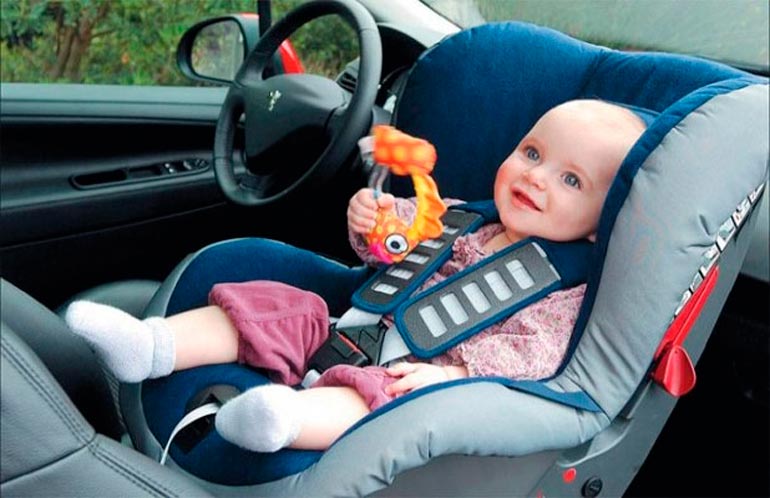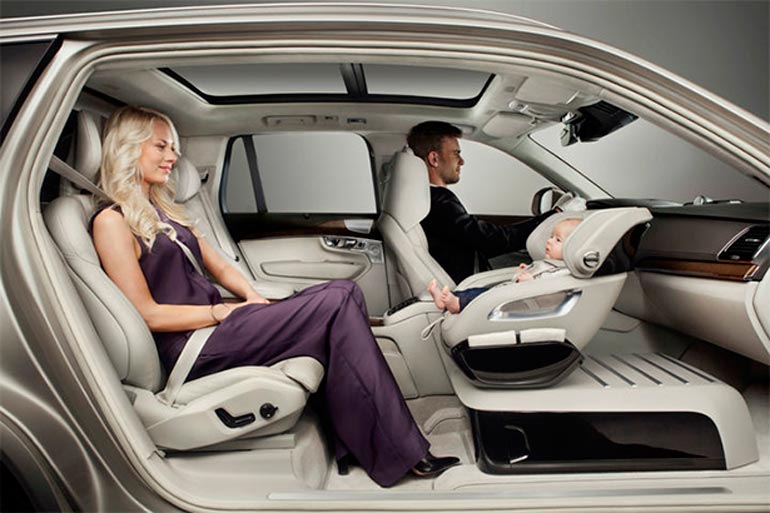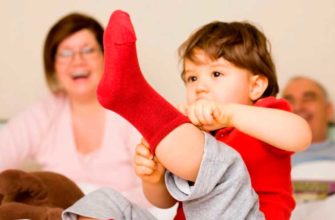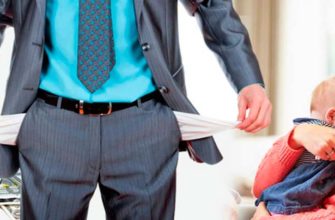Some parents prefer to carry their child in the front seat of the car. Let's try to figure out if this is a violation of traffic rules, which must be taken into account when seating the child in the front seat and, most importantly, how to protect the life and health of the child in the event of an accident or sudden braking.

Traffic rules
The basic law that guides drivers on the road is the rules of the road. Therefore, in case of doubt regarding the carriage of passengers, it would be logical to turn to them. The issue of transporting children in the front seat is clearly spelled out in the relevant paragraph of Regulation 22.9. According to them, to carry children under 12 years old in the front seat of the car is possible only with the use of special restraint devices.
The rules are not specifically about a child seat, although it relates to special devices. However, it is allowed to use other devices specially designed to safely hold the child in an emergency (for example, boosters).
One of the important requirements for special devices is compliance with the child’s weight category.
If the child is 12 years old, traffic rules are not forbidden to carry him in the front seat, fastening with a regular seat belt.
SDA does not prohibit the carriage of children in the front seat. However, the law governs mandatory compliance with safety requirements. In particular, the use of special restraint devices is necessary.
Requirements for devices, basic characteristics depend on the specific age and weight of the child. This is the only way to provide him with a sufficient level of comfort and safety in any situation.
The airbag installed in modern cars often raises questions about its safety in relation to children sitting in the zone of its operation (in the front seat).
Rules of the road clause 22.9 (transportation of people, 22.9 in particular children) for 2015-2016
22.9. Transportation of children is allowed provided that they are safe, taking into account the design features of the vehicle.
Transportation of children under 12 years of age in vehicles equipped with safety belts should be carried out using child restraints appropriate for the weight and height of the child, or other means to fasten the child with seat belts,provided by the vehicle design, and in the front seat of a car - only using child restraints.
It is forbidden to transport children under 12 years of age in the back seat of a motorcycle.
Front airbags and children
If you placed a child seat in the front seat, you should pay attention to the airbag. It is widely believed that the deployment of airbags during an accident clearly improves the safety of passengers, regardless of their height and weight. Some people think that the presence of airbags ensures the safety of the child even without the use of additional devices that include traffic rules. Are these beliefs true? The facts suggest otherwise.
During an accident, an airbag does not improve the safety of the baby in the front seat. A sharp opening of the pillow can even cause additional injuries to the child.
After attaching the child seat in the front seat, make sure that the airbag deployment mechanism is deactivated. This advice is especially important for parents fixing the cradle for babies in the front seat. It is placed with the back forward, which reduces the space between the child and the airbag. Such close proximity reinforces the shock during the deployment of the pillow during an accident.

If possible, roll back the seat with the child seat (especially the cradle) as far as possible. This will help in the event of a deployment of the airbag mechanism and provide additional “safety space” in a head-on collision.
Car seat manufacturers also recommend disabling the airbag mechanism while children are being transported to reduce the likelihood of injuries. You can verify this by reading the instructions for child seats of well-known manufacturers.
Why it is better to avoid carrying children in the front seat
The law does not prohibit the carriage of children in the front seat in a car if special devices are used to improve safety. However, there are many arguments against carrying a child in the front seat, regardless of the presence of a car seat, cradle or other device.
Most motorists rightly believe that front-seat rides are unsafe even for adults, not to mention children. Therefore, despite the legislative permissions and the presence of special car seats, many drivers do not allow themselves to think about how to go on the road, sitting the child in front. This opinion is quite reasonable. There are enough reasons to fear for the safety of the child:
- There are data from studies in the field of road safety conducted by independent expert bureaus of different countries. According to them, in almost 50% of the investigated cases of accidents involving children in front of the child seat, the cause of injuries and death was precisely the location of the seat next to the driver. If the children were sitting in the chairs in the back seat, they would not be hurt.
- An airbag that was forgotten to be disabled when the child is in front of the child can cause injuries and injuries when deploying during an accident.
- Children are very impressionable and a ride in the front seat can cause an over-emotional reaction. Children under 6 years old are often scared when they see huge cars rushing towards them. This causes sleep disorders, loss of appetite. Fright can even cause neurosis and tantrum.
- According to physiologists and pediatricians, children under 5 years old need to be carried in the car with their backs forward. This is due to the structural features of the children's skeleton. In young children, the head is disproportionately large and heavy in relation to the body, and the muscles and vertebrae of the neck are fragile. During the accident, the cervical spine is heavily loaded: the head continues to move forward, while the shoulders fastened with seat belts stop abruptly. Such overloads are especially dangerous for babies.Therefore, it is better to adhere to the recommendations of doctors and carry a small child exclusively with its back forward, so that in extreme situations the cervical vertebrae does not have to take on most of the load.
The last item is reflected in the SDA of certain European countries where the transportation of babies is prohibited other than with their backs forward. We have no ban, but no one canceled the biological features and laws of physics. It is better to draw conclusions and worry in advance about the safety of your child, without exposing him to additional risk.
Analyze each of the items listed and answer whether the child’s landing is in front of all the additional risks. It is better to seat the baby in the back seat with one of the relatives. The child will be supervised, safe and will not distract from the road.
Why do you have to put children in front
Despite the disadvantages of transporting children in the front seat, many seat the little passenger there. Each family can have its own arguments and reasons for this.
- Lack of space. When moving or on a long trip, you have to take a lot of necessary things, which are not enough luggage to accommodate. Have to pack in the back seat. A child seat takes up a lot of space, so you have to install it next to the driver in order to free up space in the back seat;
- Parents are forced to seat the child in front when traveling together with him. Leaving your baby alone unattended in the backseat is uncomfortable. It is safer if the child is in sight, so that you do not have to be distracted by him during movement. Wipe the nozzle, serve the bottle, entertain the baby, if he was more capricious when he is nearby. Of course, all this can not be done on the go. We also read: Traveling with children by car - what is important to know;
- From a certain age, children, regardless of gender, begin to dream of traveling in a car “” as adults, in front. ” This allows them to assert themselves, experience new experiences and feel older. It is advisable to explain to children about the dangers of such a trip. However, not all parents are able to convince the child, sometimes they have to surrender. A capricious child can use the whole “combat arsenal”, including tears and hysteria, in order to achieve what is desired. If the parents do not have enough experience and patience, they have to give in, going about the requirements of the child. It is especially difficult to justify a refusal if you previously had to seat the child in the front seat for objective reasons (see paragraphs 1 and 2).
There are other reasons that make the child sit in front. Personal judgments, the mood of the baby, unforeseen circumstances affect the decision. If the situation really requires the child to sit in the front seat, you should know how to protect the child as much as possible during the trip.
How to make a trip with your baby safe
If, despite the above arguments, you had to install a child seat in the front seat, remember the recommendations of experienced drivers and security experts. Following them will maximally protect the child from the sad consequences in the event of an accident.
 If you can not seat the child in front, but put the chair in the back seat - do it immediately.
If you can not seat the child in front, but put the chair in the back seat - do it immediately.- Do not teach your child to ride in the front seat. Remember - Installation of a car seat in front is only permissible in an emergency when this cannot be avoided. Such trips should not be the rule.
- Try to be as concentrated and careful as possible, try to predict any change in the traffic situation when you are carrying your baby in the front seat. However, this applies to travel in general.
- Be sure to check if the airbag mechanism is deactivated.
- Move the front seat back as much as the design of the mounts allows. Excess space between body parts and a child in an accident can save health and life.
- Get ready to meet with the traffic police, who may try to write a fine, despite having a child seat. Sometimes they may claim that the car seat is not a “special support device”. Stress resistance and legal literacy are important here. Printouts of court orders regarding similar situations will not interfere.
- Do not try to carry the child in the front seat while holding him in his arms. It is hard to imagine a more traumatic way of transporting a small passenger.
- Do not attempt to use a cradle from a regular stroller to transport the baby. It does not provide for the possibility of reliable mounting on the seat and cannot ensure the safety of the child. This method of transportation is contrary to traffic rules, so traffic police can impose an administrative fine for violating the rules.
Compliance with this list of rules will minimize the risk of transporting a child. Before deciding to place a car seat, think carefully. If there really is no way to fix it in the back seat, use the best car seats, take special care when traveling.
What car seats are suitable for children of different ages
A child car seat (or other restraint) must be fully consistent with the child’s age and height. They differ in size, method of planting the child and the mounting device.
- A child younger than a year weighing less than 10 kg is an infant carrier providing a horizontal position for the child. We also read: Do I need a car seat for a newborn child up to 1 year old?
- A child up to one and a half years old weighing up to 13 kg - a baby cocoon chair, deployed with his back against the course of movement;
- A child 1-4 years old weighing 9-18 kg - a universal child car seat with the ability to mount on any seat;
- Child 3-7 years old weighing 15-25 kg - car seat, installed by the person in the direction of movement;
- A child of 6-12 years old weighing 22-36 kg is a car seat using regular car safety belts.
Typically, the manufacturer of car seats indicates in the instructions the age for which the model is designed.
The correct selection and installation of a car seat will ensure the safety of your family trips and will allow you to fulfill the requirements of the SDA regarding the transportation of children. Try not to save money when buying a child car seat, because such a savings can cost health, even the life of a child!
We also read: 5 true facts and false beliefs about child safety in the car
New rules for transporting children in cars
[sc: rsa]









I've been fined twice for transporting a child in a car. And for the first time because the child seat was in the front seat, and the second time in the back.To my question, how can I carry a child, the inspector replied: “IN PUBLIC TRANSPORT!”. Today I’ve studied so much information, but I really haven’t found an answer. Traffic rules are interpreted in their own way if not by each inspector, so by the department for sure
I will never carry my little child in front. Since I understand my responsibility and anything can happen on the road. I try not to drive alone in a car with a child.